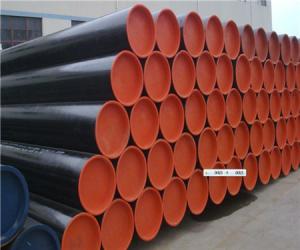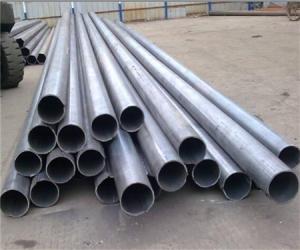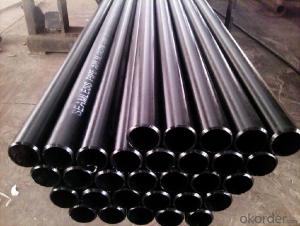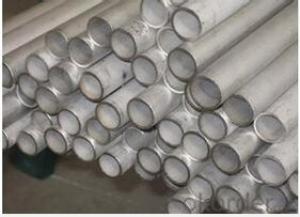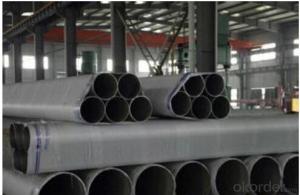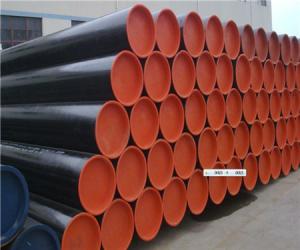Seamless Stainless Steel Pipe S31803 China Factory
- Loading Port:
- China Main Port
- Payment Terms:
- TT or LC
- Min Order Qty:
- 30 m.t.
- Supply Capability:
- 12000 m.t./month
OKorder Service Pledge
OKorder Financial Service
You Might Also Like
1、Structure of Seamless Pipe ASTM A106/53:
1.duplex S31803 stainless steel seamless pipe
2.OD:3-580MM WT:1-30MM
3.ASTM A240/789/790
4.chemical industry pipe
5.Zhejiang
2、Main Features of the Seamless Pipe ASTM A106/53:
• High manufacturing accuracy
• High strength
• Small inertia resistance
• Strong heat dissipation ability
• Good visual effect
• Reasonable price
3、Seamless Pipe ASTM A106/53 Specification:
Standard | GB, DIN, ASTM ASTM A106-2006, ASTM A53-2007 |
Grade | 10#-45#, 16Mn 10#, 20#, 45#, 16Mn |
Thickness | 8 - 33 mm |
Section Shape | Round |
Outer Diameter | 133 - 219 mm |
Place of Origin | Shandong, China (Mainland) |
Secondary Or Not | Non-secondary |
Application | Hydraulic Pipe |
Technique | Cold Drawn |
Certification | API |
Surface Treatment | factory state or painted black |
Special Pipe | API Pipe |
Alloy Or Not | Non-alloy |
Length | 5-12M |
Outer Diameter | 21.3-610mm |
Grade | 20#, 45#, Q345, API J55, API K55, API L80, API N80, API P110, A53B |
Standard | ASME, ASTM |
4、Packaging & Delivery
Packaging Details: | seaworthy package,bundles wrapped with strong steel strip |
Delivery Detail: | 15-30days after received 30%TT |
5、FAQ of Seamless Pipe ASTM A106/53:
①How is the quality of your products?
Our products are manufactured strictly according to national and internaional standard, and we take a test
on every pipe before delivered out. If you want see our quality certifications and all kinds of testing report, please just ask us for it.
Guaranteed: If products’ quality don’t accord to discription as we give or the promise before you place order, we promise 100% refund.
②How about price?
Yes, we are factory and be able to give you lowest price below market one, and we have a policy that “ for saving time and absolutely honest business attitude, we quote as lowest as possible for any customer, and discount can be given according to quantity”,if you like bargain and factory price is not low enough as you think, just don’t waste your time.Please trust the quotation we would give you, it is professional one.
③Why should you chose us?
Chose happens because of quality, then price, We can give you both.Additionally, we can also offer professional products inquiry, products knowledge train(for agents), smooth goods delivery, exellent customer solution proposals.Our service formula: good quality+good price+good service=customer’s trust
SGS test is available, customer inspection before shipping is welcome, third party inspection is no problem.
6、Seamless Pipe ASTM A106/53 Images:
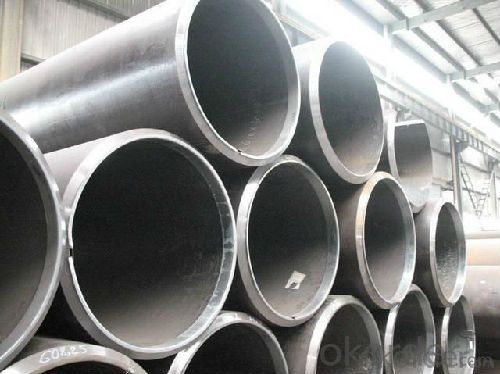
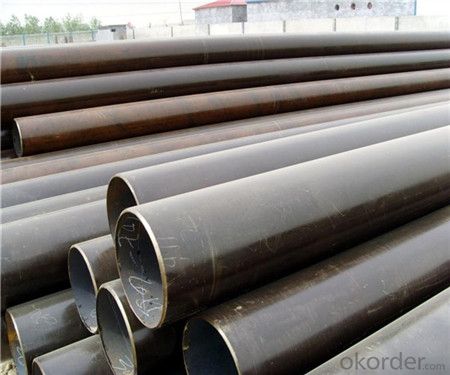
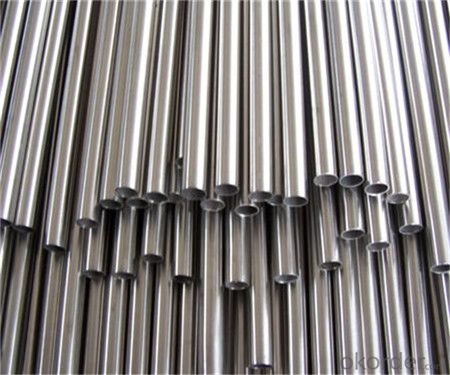
- Q: What is the difference between annealed and tempered stainless steel pipes?
- Annealed and tempered stainless steel pipes are both heat-treated to enhance their properties, but they differ in terms of their mechanical characteristics and applications. Annealed stainless steel pipes are soft and ductile due to the annealing process, which involves heating the material to a high temperature and then slowly cooling it. This process relieves internal stresses and increases the steel's flexibility, making it easier to bend and form. Annealed pipes have lower hardness and strength but are more resistant to corrosion. On the other hand, tempered stainless steel pipes undergo a different heat treatment process called tempering. After being quenched, the steel is reheated to a specific temperature and then cooled rapidly. This process improves the steel's strength, hardness, and toughness, making it more suitable for applications that require high mechanical properties. Tempered pipes have higher hardness and strength but may be slightly less resistant to corrosion compared to annealed pipes. The choice between annealed and tempered stainless steel pipes depends on the specific application. Annealed pipes are commonly used in industries that require excellent corrosion resistance and flexibility, such as food processing, pharmaceutical, and chemical industries. Tempered pipes, on the other hand, are preferred in applications that require higher strength and durability, such as construction, automotive, and aerospace industries. In summary, annealed stainless steel pipes are softer and more flexible with better corrosion resistance, while tempered stainless steel pipes are stronger and harder with slightly reduced corrosion resistance. The selection of the appropriate type depends on the mechanical requirements and the environment in which the pipes will be used.
- Q: Can stainless steel pipes be insulated with polyamide?
- Yes, stainless steel pipes can be insulated with polyamide. Polyamide is a type of plastic material that is known for its excellent insulation properties. It can be used as a coating or a lining for stainless steel pipes to provide insulation against heat or cold. The polyamide insulation helps in preventing heat loss or gain, which is essential for maintaining the desired temperature of fluids or gases flowing through the pipes. Additionally, polyamide also offers protection against corrosion and mechanical damage, further enhancing the durability and lifespan of the stainless steel pipes.
- Q: What is the difference between 304H and 304L stainless steel pipes?
- The main difference between 304H and 304L stainless steel pipes lies in their carbon content. 304H has a higher carbon content, which gives it improved high temperature strength and resistance to sensitization. On the other hand, 304L has a lower carbon content, making it more resistant to corrosion in certain environments.
- Q: Are stainless steel pipes suitable for cryogenic applications?
- Yes, stainless steel pipes are suitable for cryogenic applications. Stainless steel has excellent low-temperature properties, making it an ideal material for cryogenic applications where extremely low temperatures are involved. It offers high strength, excellent corrosion resistance, and good thermal conductivity, which are essential factors for handling cryogenic fluids or gases. Stainless steel pipes can withstand the extreme cold temperatures without losing their structural integrity or becoming brittle. Additionally, stainless steel's resistance to thermal expansion and contraction allows for reliable performance in cryogenic environments. Therefore, stainless steel pipes are a popular choice in industries such as aerospace, medical, and energy where cryogenic applications are common.
- Q: What is the welding of stainless steel?
- Many welding methods, commonly used argon arc welding, less thermal stress, less molten metal elements, forming beautiful; the remaining manual arc welding, higher requirements can be used when laser welding
- Q: What is the hardness of stainless steel pipes?
- The specific grade and treatment of the steel can cause variations in the hardness of stainless steel pipes. Stainless steel pipes exhibit a range of hardness levels, which are typically assessed using either the Rockwell scale or the Brinell scale. The hardness of stainless steel pipes surpasses that of other steel types due to the presence of alloying elements like chromium and nickel, which enhance resistance to corrosion and wear. Ordinarily, stainless steel pipes fall within the hardness range of 75 to 180 on the Rockwell scale or 150 to 300 on the Brinell scale. Nonetheless, it's worth noting that factors such as heat treatment, welding, and cold working processes can also affect the hardness.
- Q: Can stainless steel pipes be pickled and passivated?
- Stainless steel pipes do have the capability to undergo pickling and passivation. Pickling refers to the elimination of impurities and scale from the surface of the stainless steel, whereas passivation involves applying a protective oxide layer on the surface to improve its resistance to corrosion. Various acidic solutions and techniques are employed in the pickling and passivation process, depending on the specific needs of the pipes and the desired results. This procedure is commonly employed in industries such as oil and gas, chemical, and food processing to ensure the purity and durability of stainless steel pipes.
- Q: Can stainless steel pipes be used for architectural sculptures?
- Yes, stainless steel pipes can be used for architectural sculptures. Stainless steel is a versatile material that offers durability, corrosion resistance, and a sleek aesthetic. These qualities make it a popular choice for creating sculptures and structures in architectural projects. Stainless steel pipes can be manipulated into various shapes and sizes, allowing artists and architects to bring their creative visions to life. Additionally, stainless steel's ability to withstand harsh weather conditions and its low maintenance requirements make it suitable for outdoor installations. Overall, stainless steel pipes provide a reliable and visually appealing option for architectural sculptures.
- Q: What is the difference between the stainless steel pipe welded pipe and seamless pipe?
- Concentricity: seamless tube manufacturing process is the temperature of 2200 degrees F in stainless steel billet stamping a hole, at this high temperature, tool steel by stamping and drawing become soft and spiral form from the hole. Thus, the wall thickness of the pipeline is uneven and the eccentricity is high. Thus ASTM allows seamless pipe wall thickness ratio of the wall thickness difference of seamed tube. Through the seamed tube cold rolling plate precision (per roll width is 4-5 feet) made. These cold rolled plates usually have a maximum wall thickness of 0.002 inches. The steel plate is cut into a width of PI D, in which D is the outer diameter of the pipe. Tube wall thickness tolerance is very small, and the entire circumference of the wall thickness is very uniform.
- Q: Are stainless steel pipes suitable for food processing applications?
- Yes, stainless steel pipes are highly suitable for food processing applications. This is because stainless steel is resistant to corrosion, easy to clean and sanitize, and does not react with food or alter its taste. Additionally, stainless steel pipes comply with hygiene and safety standards, making them ideal for the food industry.
Send your message to us
Seamless Stainless Steel Pipe S31803 China Factory
- Loading Port:
- China Main Port
- Payment Terms:
- TT or LC
- Min Order Qty:
- 30 m.t.
- Supply Capability:
- 12000 m.t./month
OKorder Service Pledge
OKorder Financial Service
Similar products
Hot products
Hot Searches
Related keywords

